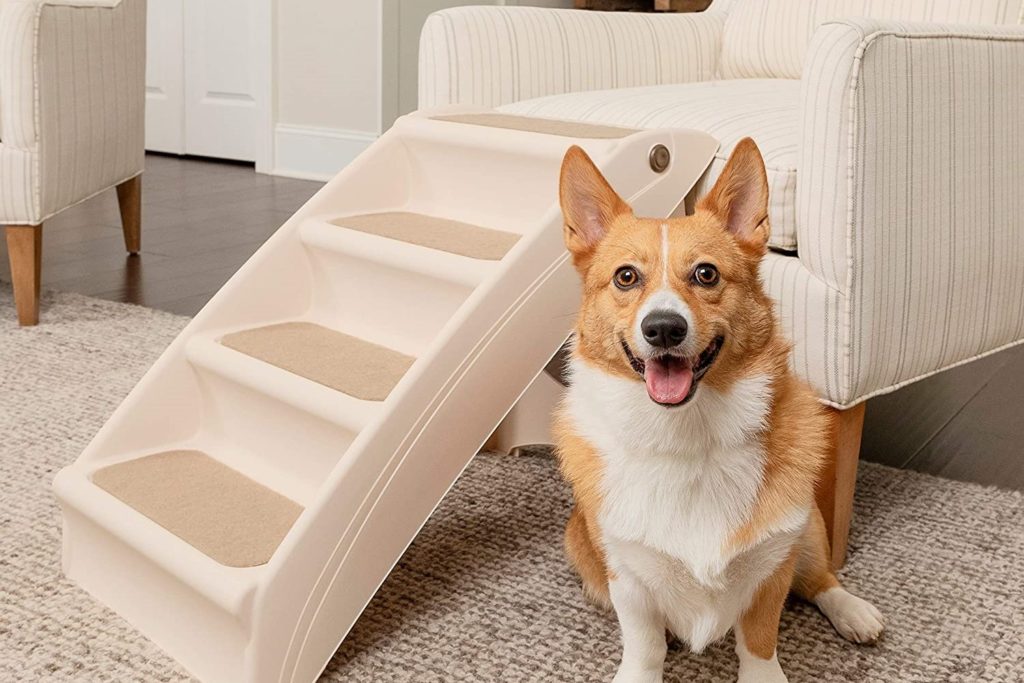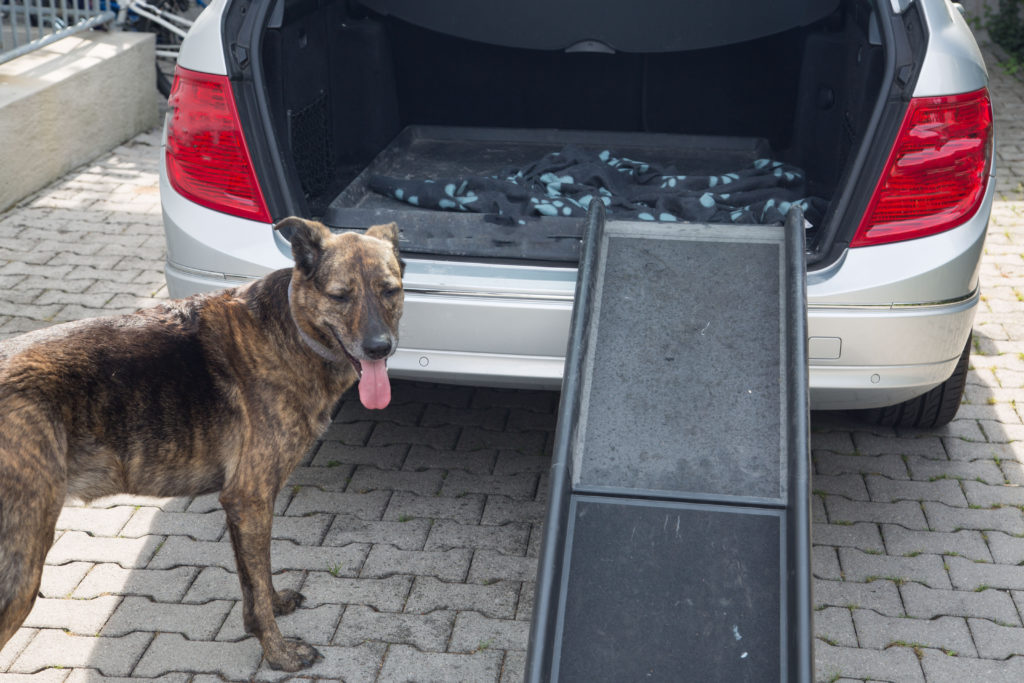Does my dog need a stair ramp?
As your dog ages, their mobility may well start to decline. Sadly, osteoarthritis is all too common in dogs from middle age onwards. Even younger dogs may well injure themselves at some point, thus reducing their mobility. Unfortunately, most dogs fail to recognise their own limitations, even when they are older and should be wiser! Luckily, in addition to veterinary treatment, there is plenty you can do to help at home – including adding a dog stair ramp
Are stairs bad for older dogs?

The simple answer is yes! For elderly dogs with muscle wastage or weak legs, stairs can put uncomfortable added pressure on the muscles and joints. Dogs must push upwards with their hind legs to climb the stairs and take considerable weight on their front legs to descend.
Of course, older dogs with good mobility may manage fine with stairs. However, excessive use is still best avoided. Not only due to the repetitive added pressure on aging joints, but also because of the risk of injury. Dogs often bound down the stairs or miss out the last few steps, which increases the risk of slips or falls.
Why might my dog need a stair ramp?

There are many possible situations where your dog could benefit from a dog stair ramp. Climbing the stairs, jumping on and off furniture and scrabbling into and out of the car can all be damaging to the joints and muscles.
Situations where your dog may benefit from dog stairs, or a dog ramp include:
Arthritis can cause pain, muscle wastage and weakness. Alongside veterinary treatment, home modifications can make a big difference to your dog’s quality of life. Dog stair ramps or dog stairs can be used to limit the use of staircases, limit jumping up and down from furniture or cars and to aid with outdoor access.
Just as with people, elderly dogs are more prone to slipping and falling. Dog ramps and stairs can be a safer option, helping to prevent slips and falls.
Small breed dogs tend to be prone to fall injuries, such as slipped discs. They also tend to be full of beans, leaping on and off the furniture at every opportunity! Over time, this repetitive strain on the joints can take its toll, contributing to arthritis and other issues, such as cruciate tears (footballers’ knee) and luxating patellas (wobbly kneecaps). Training your small breed dog to use dog stair ramps or dog stairs to climb onto and off the furniture will be much better for them than jumping.
Too much jumping is also not ideal for young, developing bones and joints. Puppies are also prone to fall injuries, while they find their balance! While many people can lift their puppies into and out of the car, for example, others may struggle. If you are unable to help your puppy, a dog ramp or stairs could be a good alternative.
Usually, if your dog is recovering from an injury your vet will prescribe rest as part of the treatment plan. This is often easier said than done! Training your pup to use a ramp or stairs rather than attempting to jump can help during the recovery process.
Similarly, if your pup is recovering from surgery they may be required to rest. This isn’t limited to orthopaedic surgery either, if they have a wound or have had abdominal surgery, then jumping and stretching can put too much pressure on their stitches.
Are dog ramps worth it?
With somany situations where a dog ramp or stairs can be considered useful, you are likely to get your money’s worth of use out of it. Of course, you could consider home-made options, such as a plank of wood with a non-slip layer over the top. Keep in mind there are many safety aspects to consider, however.
If your dog is elderly or arthritic, then a stair ramp, amongst other home modifications, can help improve quality of life.
For example, an elderly arthritic dog may be reluctant to go outside due to a small step or lip on the door frame. If they know it will either take effort or it may hurt, they are unlikely to want to do it. A ramp can really help in these situations. So, yes, I think you’d agree they are worth it in these cases.
Should I get stairs or a ramp for my dog?
There are pros and cons to both ramps and stairs and each may have its place, depending on the situation.
The benefits of dog stairs:

- Useful as an alternative to jumping onto and off the furniture
- More suitable for smaller breed dogs
- Often light, take up little space and are easily moved
The benefits of dog ramps:

- More suitable for medium and larger breeds
- A better option for accessing cars, as an alternative to staircases and for accessing the outdoors
- A better choice if your dog has developed an aversion to, or struggles with, climbing the stairs
There are many dog stairs and ramps to suit individual preferences and requirements. It’s important to find one that works for both you and your dog. For example, you could find the best ramp in the world, but if you can’t lift it, or fit it in your car, then it’s of limited use to your individual situation.
How do I choose the best ramp for my dog?
When choosing a ramp for your dog, there are several important points to consider. Possibly most importantly, the ramp must have a secure, non-slip surface. It must be able to lock securely in place, so that it won’t topple over or wobble when your dog is walking on it. The ramp needs to be wide enough for the size of your dog, so they feel secure on it. It’s also important that the angle of the ramp is not too steep, it should be a gentle incline rather than a climbing challenge!
The ramp will need to be strong enough to hold your dog’s weight, so look for one that is suitable for your dog’s size. On the other hand, if you are buying a portable ramp for use in the car, you must be able to lift it easily and it must fold or collapse to fit inside your car. Is the ramp long enough to reach your car boot or the intended furniture?
How do I choose the best stairs for my dog?
All the above criteria for choosing a dog ramp are just as important when choosing dog stairs. In addition, the steps should not be too steep, or too high. The tread depth of the step must be big enough that your dog won’t lose their footing, nor be reluctant to tread due to lack of space. The stair set should be tall enough to be flush with the surface you wish your dog to dismount on, i.e., they should walk off the top of the stairs, not step upwards off them.
How do I teach my dog to use a dog stair ramp?
As with anything new, you cannot present the ramp or stairs to your dog and expect them to know what to do, and to be happy doing it! They will need time and positive re-enforcement to become accustomed to the new feature in their lives.
For dog ramps, it’s a good idea to start with the ramp lying flat on the ground. Encourage your pup to take a step on to the ramp by holding out a treat in your hand, choose a command such as ‘up’, then offer them the treat when they achieve it. Gradually move your hand, holding a treat, further along the ramp each time. You are aiming for your pup to walk along the entire ramp, following your hand (or the treat in it!). If they jump off, withhold the treat and start again. It’s really important to discourage jumping off, since once the ramp is at an incline your pup could seriously injure themselves, were they to jump off.
It’s important to never force your dog to go up or down the stairs or ramp, as this will cause a negative association and may lead to injury.
Once your dog has mastered walking along the entire ramp without stepping off, you can start the training again at a very slight incline. It’s important to only make the ramp’s angle slightly steeper each time, otherwise your dog may panic. The same method can be used for stair training. Dogs often find going back down harder than going up, it’s a little more nerve racking! So be sure to practice that too.
What else can I do to help?

If you are looking at dog stair ramps to support your elderly or arthritic dog, then you’re making a good start. There are some other home modifications which could benefit your dog. Here are a few tips:
- Use stair gates to restrict access to staircases.
- If you have hard flooring, you could put down some non-slip rugs or mats to provide pathways for your dog. This way they aren’t having to walk across slippery floors, since repeated slips will worsen arthritis.
- Upgrade their bed to an orthopaedic or memory foam dog bed. Make sure the sides aren’t too high and that they can comfortably step on to it.
- Raise their food and water bowl. This will put less pressure on their necks, as they won’t have to strain too low. You can buy raised feeders, or you can create a raised feeding station yourself.
- Make sure your dog is warm enough, as the cold will cause arthritis to flare up. You can buy coats for outdoor use, but don’t forget to keep them warm inside too.
- Use a harness to help your dog getting up from laying, or as an extra support when using the dog stair ramp.
It’s important to try to plan modifications around your dog’s mental wellbeing too. As an example, if their favourite place to sleep is cuddled up next to you on the sofa, they won’t thank-you for suddenly restricting access in the interest of preventing them jumping. You could consider a dog stair ramp in this situation instead.
Repetitive strain on joints, bones and muscles from repeated slips or falls really exacerbates arthritis and injuries, and is detrimental to ageing joints. Dog stairs and dog ramps can play a useful role in keeping your dog mobile, safely. They can also help your own physical wellbeing, by avoiding the need to repeatedly lift your dog. As with anything safety is key, so a dog stair ramp must be good quality and stable, with a non-slip surface.




